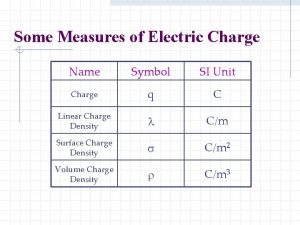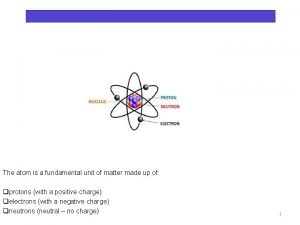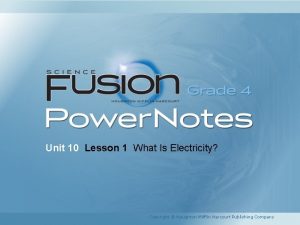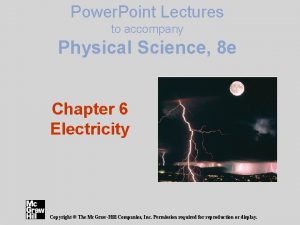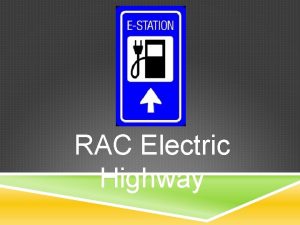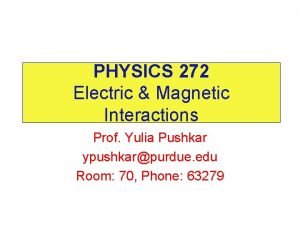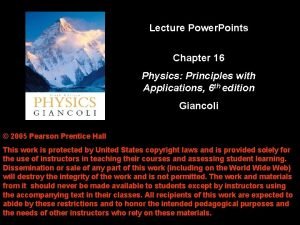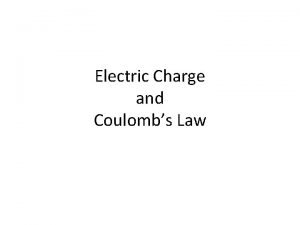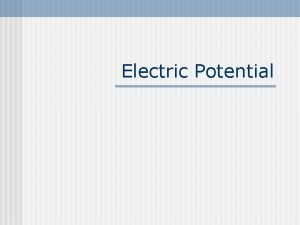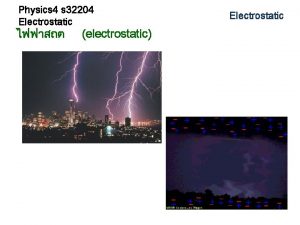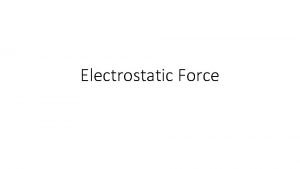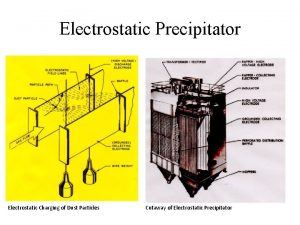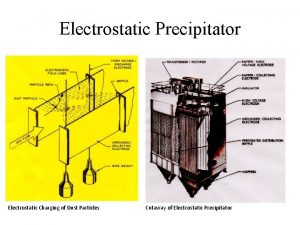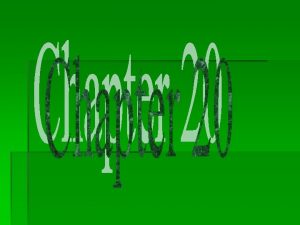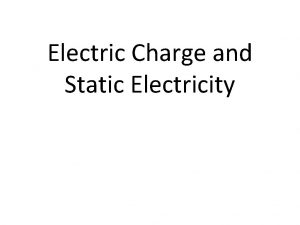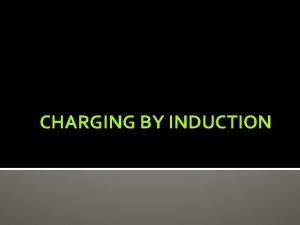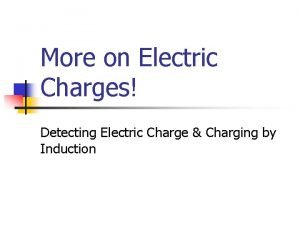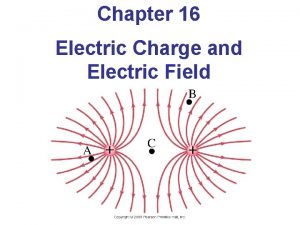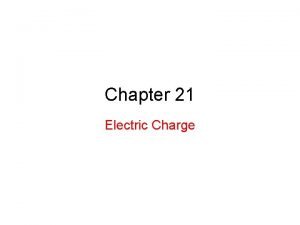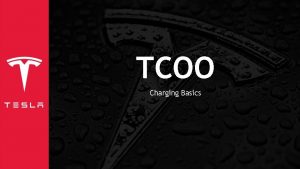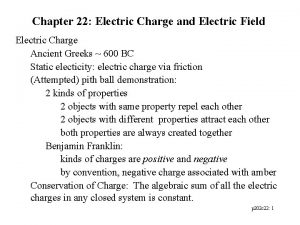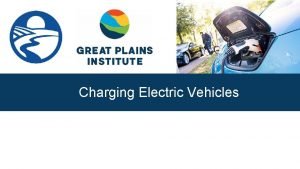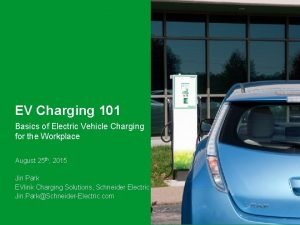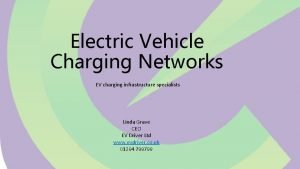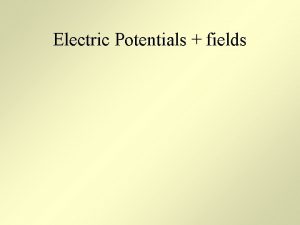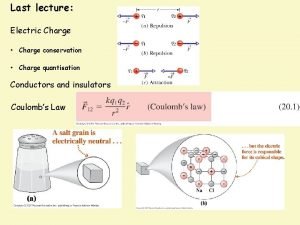Units of Chapter 15 Electric Charge Electrostatic Charging

![Electric Charge • • Transferred (not destroyed) Symbol: q, Q [coulomb, C] Q = Electric Charge • • Transferred (not destroyed) Symbol: q, Q [coulomb, C] Q =](https://slidetodoc.com/presentation_image/f8fadbe46be18f44ff4382523c528f45/image-2.jpg)








![Electric Field • • • Symbol: E [N/C] E = F/q E and F Electric Field • • • Symbol: E [N/C] E = F/q E and F](https://slidetodoc.com/presentation_image/f8fadbe46be18f44ff4382523c528f45/image-11.jpg)








- Slides: 19

Units of Chapter 15 Electric Charge Electrostatic Charging Electric Force Electric Field Conductors and Electric Fields Gauss’s Law for Electric Fields: A Qualitative Approach Homework: 9, 13, 17, 20, 29, 31, 36, 47, 57, 76
![Electric Charge Transferred not destroyed Symbol q Q coulomb C Q Electric Charge • • Transferred (not destroyed) Symbol: q, Q [coulomb, C] Q =](https://slidetodoc.com/presentation_image/f8fadbe46be18f44ff4382523c528f45/image-2.jpg)
Electric Charge • • Transferred (not destroyed) Symbol: q, Q [coulomb, C] Q = ±Ne (N = integer, e = 1. 6 E-19 C) Like repel, Unlike attract, with force ~ 1/distance 2 • Atom (Wilson) • / 2

Charge and Matter • ordinary matter: protons, neutrons, electrons • proton charge = +1 e • neutron charge = 0 • electron charge = -1 e • Conductors – one or more electrons are free to move • Insulators - no free electrons 3

Charging • Friction: rub two dissimilar materials. Ex. wool rubbed against plastic results in + wool, and – plastic • Induction: charged object near a conductor, induces charge separation • / 4

Coulomb’s Law ke = 9. 0 x 109 N m 2/C 2. q 1 r q 2 5

Example + + • +1 nanocoulomb charge at origin, another +1 nanocoulomb charge is at x = 1 meter. • force = 9 E 9(1 E-9)/1 x 1 = 9 E-9 N • force on charge at origin is in “negative” direction • force on charge at 1 meter is in “positive” direction //// 6

Example - + • -1 nanocoulomb charge at origin, +1 nanocoulomb charge is at x = 1 meter. • force = 9 E 9(1 E-9)/1 x 1 = 9 E-9 N • force on -charge at origin is in “positive” direction • force on +charge at 1 meter is in “negative” direction • does formula tell us these directions? 7

3 or more charges • force on each charge is vector sum of forces due to all other charges • method: • add x-components of all forces • add y-components of all forces • change to polar form if desired //// 8

Example Force: 1) 10 n. C is at (0, 0. 5) meters 2) -5 n. C is at (0. 5, 0) meters Calculate force on 1 n. C at (0, 0). Force = 180 n. N Right + 360 n. N Down 9

Fields • • what is fundamental: wind or force on sail? field or force on charge? How to define? wind: force per unit area field: force per unit charge / 10
![Electric Field Symbol E NC E Fq E and F Electric Field • • • Symbol: E [N/C] E = F/q E and F](https://slidetodoc.com/presentation_image/f8fadbe46be18f44ff4382523c528f45/image-11.jpg)
Electric Field • • • Symbol: E [N/C] E = F/q E and F are parallel vectors wind exists at places without sails field exists at places without charges wind is independent of sail used to measure it • field is independent of charge used to measure it 11

Electric Field Demo • In oil • http: //video. google. com/videoplay? docid=879375962512 6360449&ei=b. Tb. BSLa. CEYrgw. HE 57 Xo. CQ&q=electric+field+lines&vt=lf&hl=en • On a flame: • http: //www. youtube. com/watch? v=MPFkp 2 Hr. Ecs

Field due to Point Charge • What is field around charge Q? • field is force on another charge, q, divided by the size of charge of q • if q is “r” meters from Q, then Force F = k. Qq/r 2. • field E = F/q = (k. Qq/r 2)/q = k. Q/r 2. • field around Q does not depend on q. • E is outward if Q is +, inward if Q is - // 13

Electric Field Lines • • • Drawn parallel to the electric field Arrows tell us the direction of E Density of lines tells us the strength of E + charges move in direction of arrows - charges move in opposite dir. of arrows 14

Field Example • • • Q = +4 n. C at origin, “P” at (1, 0) meters Ep = k. Q/r^2 = (9 E 9)(4 E-9)/1^2 = 36 N/C F = q. E. Force on charge q = 2 n. C at P is: F = (2 E-9)(36 N/C) = 72 E-9 N in +x dir. Force on charge q = -2 n. C at P is: F = (2 E-9)(36 N/C) = 72 E-9 N in -x dir. 15

Field Example: Q = +8 n. C at (0, 0), “P” at (2, 0) meters 16

Calculating E for 2 or more Point Charges 1. 2. 3. 4. 5. 6. Calc. distance from each charge to “P” Calc. size of each field at P Calc. sine & cosine for each direction Calc. x, y components of each field Add x, y components separately Convert x, y to E, q (polar coords. )

Component Example: +1 n. C at (4, 3) meters, “P” at origin 18

15 Summary • charge is quantized & conserved • due to protons and electrons • conductivity depends on availability of free electrons • Coulomb’s law describes forces • field E = F/q • force and field are vector sums 19
 Chapter 21 electric charge and electric field
Chapter 21 electric charge and electric field Chapter 21 electric charge and electric field
Chapter 21 electric charge and electric field Coulombs units
Coulombs units Chapter 21 electric charge and electric field
Chapter 21 electric charge and electric field Linear charge density symbol name
Linear charge density symbol name Charge on proton
Charge on proton Difference between charge and electric charge
Difference between charge and electric charge Difference between charge and electric charge
Difference between charge and electric charge Joshuas law unit 10 lesson 1
Joshuas law unit 10 lesson 1 Electrostatic charge
Electrostatic charge Rac electric highway
Rac electric highway Santa clara fleet management electric vehicle charging
Santa clara fleet management electric vehicle charging Chapter 6 electricity section 1 electric charge answers
Chapter 6 electricity section 1 electric charge answers Chapter 17 section 1 electric charge and force answer key
Chapter 17 section 1 electric charge and force answer key Bd microfine
Bd microfine Variable costing income statement
Variable costing income statement Nanocoulomb
Nanocoulomb Units of charge
Units of charge Charge unit
Charge unit Parallel plate equipotential lines
Parallel plate equipotential lines




